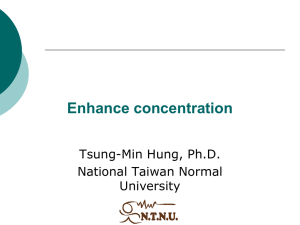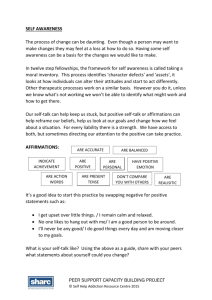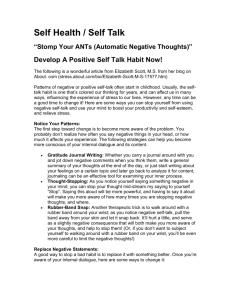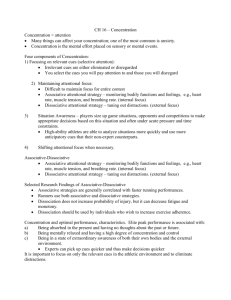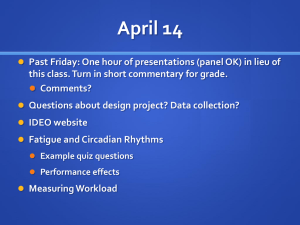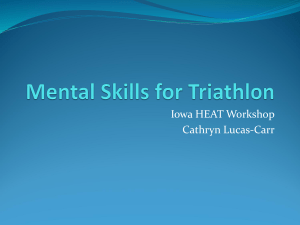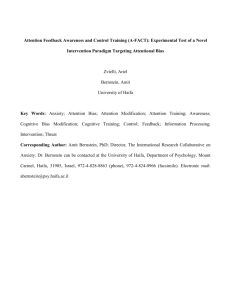Chapter 16: Concentration What Is Concentration? Types of Attentional Focus Shifting Attentional Focus
advertisement
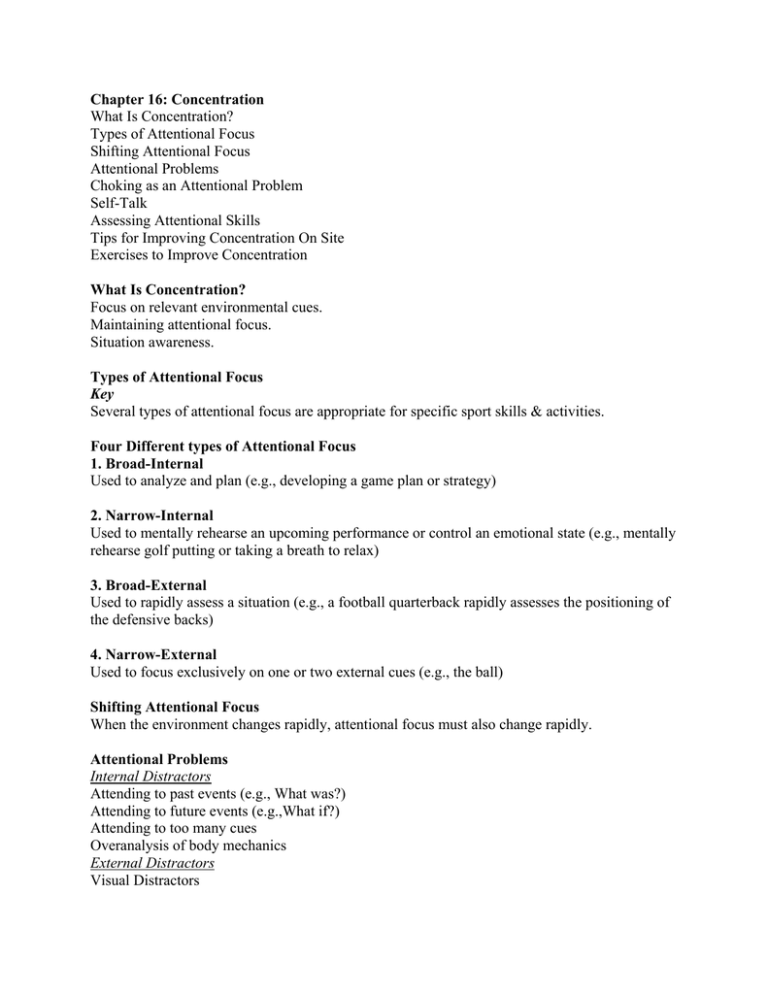
Chapter 16: Concentration
What Is Concentration?
Types of Attentional Focus
Shifting Attentional Focus
Attentional Problems
Choking as an Attentional Problem
Self-Talk
Assessing Attentional Skills
Tips for Improving Concentration On Site
Exercises to Improve Concentration
What Is Concentration?
Focus on relevant environmental cues.
Maintaining attentional focus.
Situation awareness.
Types of Attentional Focus
Key
Several types of attentional focus are appropriate for specific sport skills & activities.
Four Different types of Attentional Focus
1. Broad-Internal
Used to analyze and plan (e.g., developing a game plan or strategy)
2. Narrow-Internal
Used to mentally rehearse an upcoming performance or control an emotional state (e.g., mentally
rehearse golf putting or taking a breath to relax)
3. Broad-External
Used to rapidly assess a situation (e.g., a football quarterback rapidly assesses the positioning of
the defensive backs)
4. Narrow-External
Used to focus exclusively on one or two external cues (e.g., the ball)
Shifting Attentional Focus
When the environment changes rapidly, attentional focus must also change rapidly.
Attentional Problems
Internal Distractors
Attending to past events (e.g., What was?)
Attending to future events (e.g.,What if?)
Attending to too many cues
Overanalysis of body mechanics
External Distractors
Visual Distractors
Auditory Distractors
Gamesmanship
Choking
An attentional process that leads to impaired performance and the inability to retain control over
performance without outside assistance
The Choking Process
Conditions leading to choking
1. Important competition
2. Critical plays in a competition
3. Evaluation by coaches, peers, and parents
Physical changes
1. Increased muscle tension
2. Increased breathing rate
3. Racing heart rate
Attentional changes
1. Internal focus
2. Narrow focus
3. Reduced flexibility
Performance impairment
1. Timing and coordination breakdown
2. Muscle tightness and fatigue
3. Rushing
4. Inability to attend to task-relevant cues
Self-Talk
Any self-statement or thought
How self-talk works (the process)
Uses of self-talk
skill acquisition
breaking bad habits
initiating action
sustaining effort
Event (environmental stimulation)
Missing an important shot in a tennis match
Missing an important shot in a tennis match
A setback in rehabilitating a knee injury
A setback in rehabilitating a knee injury
Self-talk (perception/ evaluation)
"What an idiot I am I'll never win now."
"Keep your eye on the ball this match isn't over."
"I'll never get back in the starting lineup."
"This type of injury just takes time to heal, so I need to continue to work hard."
Response (emotional, physiological, behavioral)
Anger, hopelessness, increased muscle tension
Better concentration, optimism, calmness
Hopelessness, anger, frustration
Optimism, motivation, increased effort
Changing self-talk
thought stopping
changing negative self- talk to positive self-talk
Assessing Attentional Skills
Use the Test of Attention & Interpersonal Style (TAIS)
Observation (e.g., Behavioral analysis)
Psychophysiological Measures (e.g., EEG, HR)
Effective versus ineffective attentional styles:
Effective attenders can attend to several stimuli without getting over loaded and can narrow
attentional focus without leaving out important information.
Ineffective attenders are easily confused with multiple stimuli.
TAIS as a trait measure:
The TAIS is a general trait measure. Sport-specific measures also exist. The TAIS is not without
problems.
Tips for Improving Concentration on Site
1. Practice with distractions present.
2. Use cue words to focus (instructional & motivational words).
3. Employ nonjudgmental thinking.
4. Establish routines
5. Develop competitive plans
6. Practice eye control.
7. Stay focused in the present.
8. Overlearn skills.
Sport Specific Examples of Performance Routines
Golf shot
1. Take a deep breath.
2. Look at the fairway lie and assess the weather conditions and possible hazards. 3. Look at the
target and decide on the shot required.
4. Picture your target and the shot you want to hit. Imagine not only your swing but also the
trajectory of the ball and its final resting place.
5. Address the ball, adjusting and readjusting your position until you feel comfortable.
6. Feel the shot with your whole body.
7. Again picture the desired shot and, while feeling the shot, think target 8. Think target and
swing.
Tennis serve
1. Determine positioning and foot placement.
2. Decide on service type and placement.
3. Adjust racquet grip and ball.
4. Take a deep breath.
5. Bounce the ball for rhythm.
6. See and feel the perfect serve.
7. Focus on ball toss and serve to programmed spot.
Exercises to Improve Concentration
1. Learn to shift motivation.
2. Learn to maintain focus.
3. Search for relevant cues.
4. Rehearse game concentration.
Distorted Thinking and Self-Talk (Chapters 14 and 16)
Irrational Beliefs
No pain, no gain.
Give 110% all the time.
Practice makes perfect.
Winning isn’t everything, it’s the only thing.
What are Cognitive Strategies?
Cognitive Strategies are techniques that focus on thoughts and their influence on behavior.
Why use Cognitive Strategies in Sport?
Changing the way one thinks about a situation or one’s outlook can lead to a positive effect on
sport enjoyment and performance.
Activity: Identifying irrational or ineffective thoughts
Try to remember something you have said to yourself before, during, or after sports
participation. Note your answers to the following 5 questions.
Identifying irrational or ineffective thoughts:
Is the belief based on objective reality?
Is it helpful?
Is it used in reducing interpersonal conflicts?
Does it help in reaching goals?
Does it reduce emotional conflict?
Irrational or Ineffective Beliefs:
If the answer to any of the previous 5 questions was "no", the belief you had may have hindered
your athletic performance in some way.
Distorted Thinking Styles
Perfectionism
Catastrophizing
Self-worth depends on achievement
Personalization
Fallacy of fairness
Blaming
Polarized thinking
One-trial generalizations
Changing Irrational Thoughts
Thought Stoppage
Changing Negative Thoughts to Positive
Developing Positive Affirmations
Countering
Reframing
Cognitive Restructuring
Self-Talk
Any self-statement or thought
Techniques used to identify self-talk:
Retrospection - remembering the feelings and thoughts associated with very good or very poor
performances.
Imagery - reliving and re-creating past performances can increase awareness of self-talk usage.
Observation - watching or recording performances is helpful for those who verbalize or display
their thoughts and feelings externally.
Self-talk logs - keeping a daily record or journal to keep track of self-statements, their triggers,
and the resulting consequences or outcomes.
Why Use Positive Self-Talk?
Positive self-talk enhances self-esteem, motivation, attentional focus, and performance.
Negative self-talk is counterproductive and usually causes anxiety which gets in the way of
reaching goals.
Positive self-talk helps you focus on the present and keep your mind from wandering.
Uses of Positive Self-Talk
Learning new skills
Breaking bad habits
Initiate action
Sustain effort
Key:
Use positive cue words to focus your attention on producing a successful performance.
Developing Positive Affirmations
List positive statements that represent
past performance and effort
personal abilities and/or characteristics
aspects of skills, training, and personal beliefs
Repeat the affirmation on a regular basis
Use them in training and during competition
May want to periodically change them to keep them fresh for maintaining focus
Keep doing affirmations even when your positive
Thought Stoppage
Develop an awareness of the unwanted thought(s).
Create a trigger to interrupt or stop the counterproductive thought(s). This trigger can be a
verbal response
visual picture
physical action
Countering
Create an internal debate
Develop an awareness of the self-defeating thought(s)
Gather evidence from a variety of reliable sources to refute the self-defeating thoughts or
negative belief.
Reframing
I’m going to embarrass myself against this higher ranked opponent.
I’m going to see how good I’ve gotten and where I need improvement
Define key terms and answer review questions
Review for Final
Some Key Terms/Concepts
Trait-State Sport Confidence Inventory
anxiety reduction techniques
arousal inducing techniques
autogenic training (Schultz & Luthe)
biofeedback (Daniels & Landers)
breath control
cognitive affective stress
stress management training (Smith)
imagery evaluation
imagery training/programs
internal & external imagery
progressive relaxation (Jacobson)
psychological skills hypothesis
Psychological Skills Inventory for Sport (PSIS)
PST programs
psychoneuromuscular theory
ideo-motor principle
relaxation response (Benson)
relaxation tips
self-awareness of arousal
self-confidence
self-esteem
self-efficacy theory (Bandura)
sources of efficacy
self-expectations
systematic desensitization (Wolpe)
coach expectations
self-fulfilling prophesy
benefits of confidence
optimal confidence
goal setting
objective goals vs. subjective goals
outcome goals vs. performance goals
goal setting principles
goal setting staircase
concentration
attentional strategies
dissociation & association
cue words
self-talk
Nideffer's TAIS
The choking process
techniques to improve self-talk
routines
nonjudgmental thinking
eye control
focused in the present
attentional shifting
grid concentration
{ Read the Review Questions }
1. Provide 2 techniques for improving self-talk.
2. Give 6 on-site tips for improving concentration.
3. Compare and contrast Symbolic Learning Theory and Psychoneuromuscular Theory as they
relate to imagery.
4. Why do players and coaches neglect PST?
5. Why does goal setting work?
6. Identify five common problems with goal setting.
7. Describe Bandura's self-efficacy theory as it relates to athletic performance.
8. Provide an example of Nideffer's Broad-Internal type of attentional focus.
Research to know
Orlick & Partington (Canadian's mental preparation)
Suinn - skier's legs (imagery)
Feltz & Landers (imagery rehearsal)
Vealey (psychological interventions)
Greenspan & Feltz (PST effectiveness)
Mahoney & Avener (expectations)
Nelson & Furst (arm wrestling and expectations)
Rosenthal & Jacobson (teacher expectancies)
Gould (detailed plans)
Burton (basketball skills and goal setting)
Nideffer (attentional focus)
